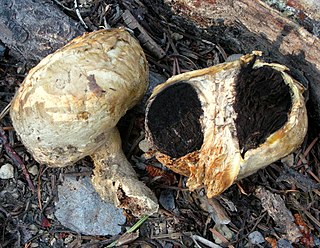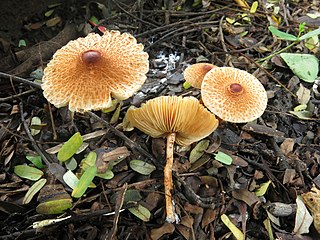
Lepiota is a genus of gilled mushrooms in the family Agaricaceae. All Lepiota species are ground-dwelling saprotrophs with a preference for rich, calcareous soils. Basidiocarps are agaricoid with whitish spores, typically with scaly caps and a ring on the stipe. Around 400 species of Lepiota are currently recognized worldwide. Many species are poisonous, some lethally so.

The Agaricaceae are a family of basidiomycete fungi and include the genus Agaricus, as well as basidiomycetes previously classified in the families Tulostomataceae, Lepiotaceae, and Lycoperdaceae.

Echinoderma is a genus of fungi in the family Agaricaceae. Its members were for a long time considered to belong to genus Lepiota and the group was then circumscribed by French mycologist Marcel Bon in 1981 as a subgenus of Cystolepiota before he raised it to generic status in 1991.

The Hygrophoraceae are a family of fungi in the order Agaricales. Originally conceived as containing white-spored, thick-gilled agarics, including Hygrophorus and Hygrocybe species, DNA evidence has extended the limits of the family, so it now contains not only agarics, but also basidiolichens and corticioid fungi. Species are thus diverse and are variously ectomycorrhizal, lichenized, associated with mosses, or saprotrophic. The family contains 34 genera and over 1000 species. None is of any great economic importance, though fruit bodies of some Hygrocybe and Hygrophorus species are considered edible and may be collected for sale in local markets.

The Clavariaceae are a family of fungi in the order Agaricales. Originally the family contained most of the clavarioid fungi, but in its current sense is more restricted, albeit with a greater diversity of basidiocarp forms. Basidiocarps are variously clavarioid or agaricoid (mushroom-shaped), less commonly corticioid or hydnoid.

Macrolepiota is a genus of white spored, gilled mushrooms of the family Agaricaceae. The best-known member is the parasol mushroom (M. procera). The widespread genus contains about 40 species.

Nidularia is a genus of nine species of fungi in the family Agaricaceae. Their fruit bodies resemble tiny egg-filled bird nests. The name comes from the Latin nidus meaning nest. The related genus Mycocalia was segregated from Nidularia in 1961 based on differences in the microscopic structure of the peridium.

Macrolepiota clelandii, commonly known as the slender parasol or graceful parasol, is a species of mushroom-forming fungus in the family Agaricaceae. The species is found in Australia and New Zealand, where it fruits singly or in small groups on the ground in eucalypt woodlands, parks, and roadsides. It is a tall mushroom up to roughly 20 cm (8 in), with a broad cap covered with distinctive rings of dark brown scales. The whitish gills on the cap underside are closely spaced and free from attachment to the slender stipe, which has a loose ring on its upper half, and a bulbous base. The edibility of the mushroom is not known with certainty, but closely related parasol mushrooms are edible and some are very sought after.

Arachnion is a genus of gasteroid fungi in the family Agaricaceae.
Clarkeinda is a genus of fungi in the family Agaricaceae. According to the Dictionary of the Fungi, the widespread genus contains five species. Species in this genus, especially Clarkeinda trachodes, are only distributed in south Asia and southeast Asia.
Endoptychum is a genus of secotioid fungi in the family Agaricaceae. Like the majority of secotioid taxa, the individual species of Endoptychum are thought to be recent mutations from agaricoid species, hence, Endoptychum is likely not a valid monophyletic genus.

Gyrophragmium is a genus of fungi in the family Agaricaceae. The genus was circumscribed by French botanist Camille Montagne in 1843.

Leucoagaricus is a genus of fungi in the family Agaricaceae. As of March 2023 there are over 200 accepted species of Leucoagaricus with ongoing research into the genus adding several more each year. Leucocoprinus is a similar genus and considered by some sources to be indistinct from Leucoagaricus based on genetic data that demonstrates they are monophyletic. Species are separated into these genera based on macroscopic features such as cap striations in Leucocoprinus or the more persistent basidiocarps (mushrooms) of Leucoagaricus as well as microscopic features such as the lack of a germ pore in Leucoagaricus species. As a result of the similarities and disagreement on taxonomy, many of the species within these genera have formerly been classified in the other and may still be known by previous classifications. For instance the species Leucoagaricus gongylophorus is cultivated by fungus-growing ants but was formerly known as Leucocoprinus gongylophorus whilst other species cultivated by the lesser attine ants are still classified as undescribed Leucocoprinus species.
Lepiota viridigleba is a species of sequestrate fungus in the family Agaricaceae. It was first described as new to science by mycologist Michael Castellano in 1995, based on collections made among Populus roots in California. The fungus was initially called Amogaster viridiglebus and tentatively placed in the order Boletales. Molecular analysis revealed the fungus to be a member of the genus Lepiota, and it was transferred to that genus in 2013.

Agaricus inapertus is a species of secotioid fungus in the genus Agaricus. It was first described by American mycologists Rolf Singer and Alexander H. Smith in 1958 as Endoptychum depressum. Molecular analysis later proved it to be aligned with Agaricus, and it was formally transferred in a 2003 publication.
Eriocybe is a fungal genus in the family Agaricaceae. Circumscribed by mycologist Else Vellinga in 2011, it is a monotypic genus, containing the single species Eriocybe chionea, found in northern Thailand. The genus name is derived from the Ancient Greek words ἔριον, meaning "wool" and κύβη, "head". The specific epithet comes from the Latin translation of the Greek χιόνεος, meaning "snow white".

Lepiota bengalensis is a species of the fungal family Agaricaceae. It was the first generic report for Bangladesh, described as a new species to science in 2016. It is only known from Bangladesh.













